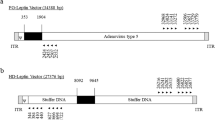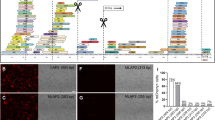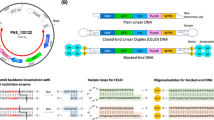Abstract
Tissue-specific transgene expression is a valuable research tool and is of great importance in delivering toxic gene products with adenovirus vectors to tumors. Limiting cytotoxic gene expression to the target cells is highly desirable. While a number of successful applications of tissue- and tumor-specific gene expression using Ad vectors has been reported, cloning of some promoters into Ad vectors resulted in modulation or loss of tissue specificity. This phenomenon is likely the result of the interaction of E1A enhancer (and possibly other Ad sequences) with the promoter cloned in the E1 region. We have compared performance parameters of prostate-specific and tet-regulatable promoters in plasmids containing the terminal repeat sequences of Ad5 with or without the E1A enhancer. Subsequently, adenoviral vectors were constructed containing identical expression units either in the E1 region or near the right ITR, and tested in several cell lines. Here, we report that promoters placed near the right ITR of Ad5 retain higher selectivity and lower background expression in both plasmid and adenovirus vectors. We confirm that the E1A enhancer can interfere with the desired activity of nearby promoters, and describe an alternative transgene insertion site for construction of Ad vectors.
This is a preview of subscription content, access via your institution
Access options
Subscribe to this journal
Receive 12 print issues and online access
$259.00 per year
only $21.58 per issue
Buy this article
- Purchase on Springer Link
- Instant access to full article PDF
Prices may be subject to local taxes which are calculated during checkout




Similar content being viewed by others
References
Levrero M et al. Defective and nondefective adenovirus vectors for expressing foreign genes in vitro and in vivo Gene 1991 101: 195–202
Baskar JF et al. The enhancer domain of the human cytomegalovirus major immediate–early promoter determines cell type-specific expression in transgenic mice J Virol 1996 70: 3207–3214
Baldwin HS, Mickanin C, Buck C . Adenovirus-mediated gene transfer during initial organogenesis in the mammalian embryo is promoter-dependent and tissue-specific Gene Therapy 1997 4: 1142–1149
Shering AF et al. Cell type-specific expression in brain cell cultures from a short human cytomegalovirus major immediate–early promoter depends on whether it is inserted into herpesvirus or adenovirus vectors J Gen Virol 1997 78: 445–459
Haack A et al. Highly sensitive and species-specific assay for quantification of human transgene expression levels Haemophilia 1999 5: 334–339
Acsadi G et al. Interferons impair early transgene expression by adenovirus-mediated gene transfer in muscle cells J Mol Med 1998 76: 442–450
Jooss K, Yang Y, Fisher KJ, Wilson JM . Transduction of dendritic cells by DNA viral vectors directs the immune response to transgene products in muscle fibers J Virol 1998 72: 4212–4223
Gutierrez AA, Lemoine NR, Sikora K . Gene therapy for cancer (see comments) Lancet 1992 339: 715–721
Arbuthnot PB et al. In vitro and in vivo hepatoma cell-specific expression of a gene transferred with an adenoviral vector Hum Gene Ther 1996 7: 1503–1514
Dematteo RP et al. Engineering tissue-specific expression of a recombinant adenovirus: selective transgene transcription in the pancreas using the amylase promoter J Surg Res 1997 72: 155–161
Griscelli F et al. Heart-specific targeting of beta-galactosidase by the ventricle-specific cardiac myosin light chain 2 promoter using adenovirus vectors Hum Gene Ther 1998 9: 1919–1928
Navarro V et al. Efficient gene transfer and long-term expression in neurons using a recombinant adenovirus with a neuron-specific promoter Gene Therapy 1999 6: 1884–1892
Steiner MS, Zhang Y, Carraher J, Lu Y . In vivo expression of prostate-specific adenoviral vectors in a canine model Cancer Gene Ther 1999 6: 456–464
Babiss LE, Friedman JM, Darnell JE Jr . Cellular promoters incorporated into the adenovirus genome: effects of viral regulatory elements on transcription rates and cell specificity of albumin and beta-globin promoters Mol Cell Biol 1986 6: 3798–3806
Imler JL et al. Targeting cell-specific gene expression with an adenovirus vector containing the lacZ gene under the control of the CFTR promoter Gene Therapy 1996 3: 49–58
Ring CJ, Harris JD, Hurst HC, Lemoine NR . Suicide gene expression induced in tumour cells transduced with recombinant adenoviral, retroviral and plasmid vectors containing the ERBB2 promoter Gene Therapy 1996 3: 1094–1103
Shi Q, Wang Y, Worton R . Modulation of the specificity and activity of a cellular promoter in an adenoviral vector Hum Gene Ther 1997 8: 403–410
Hatfield L, Hearing P . Redundant elements in the adenovirus type 5 inverted terminal repeat promote bidirectional transcription in vitro and are important for virus growth in vivo Virology 1991 184: 265–276
Imperiale MJ, Hart RP, Nevins JR . An enhancer-like element in the adenovirus E2 promoter contains sequences essential for uninduced and E1A-induced transcription Proc Natl Acad Sci USA 1985 82: 381–385
Yang TT, Sinai P, Kitts PA, Kain SR . Quantification of gene expression with a secreted alkaline phosphatase reporter system Biotechniques 1997 23: 1110–1114
Hearing P, Shenk T . The adenovirus type 5 E1A transcriptional control region contains a duplicated enhancer element Cell 1983 33: 695–703
Steinwaerder DS, Lieber A . Insulation from viral transcriptional regulatory elements improves inducible transgene expression from adenovirus vectors in vitro and in vivo Gene Therapy 2000 7: 556–567
Hearing P, Shenk T . The adenovirus type 5 E1A enhancer contains two functionally distinct domains: one is specific for E1A and the other modulates all early units in cis Cell 1986 45: 229–236
Bruder JT, Hearing P . Nuclear factor EF-1A binds to the adenovirus E1A core enhancer element and to other transcriptional control regions Mol Cell Biol 1989 9: 5143–5153
Vassaux G, Hurst HC, Lemoine NR . Insulation of a conditionally expressed transgene in an adenoviral vector Gene Ther 1999 6: 1192–1197
Grable M, Hearing P . Cis and trans requirements for the selective packaging of adenovirus type 5 DNA J Virol 1992 66: 723–731
Berger J et al. Secreted placental alkaline phosphatase: a powerful new quantitative indicator of gene expression in eukaryotic cells Gene 1988 66: 1–10
Eggermont J, Proudfoot NJ . Poly(A) signals and transcriptional pause sites combine to prevent interference between RNA polymerase II promoters EMBO J 1993 12: 2539–2548
Kasper S et al. Selective activation of the probasin androgen-responsive region by steroid hormones J Mol Endocrinol 1999 22: 313–325
Schuur ER et al. Prostate-specific antigen expression is regulated by an upstream enhancer J Biol Chem 1996 271: 7043–7051
Gossen M, Bujard H . Tight control of gene expression in mammalian cells by tetracycline-responsive promoters Proc Natl Acad Sci USA 1992 89: 5547–5551
Rubinchik S et al. Adenoviral vector which delivers FasL-GFP fusion protein regulated by the tet-inducible expression system Gene Therapy 2000 7: 875–885
Massie B et al. Inducible overexpression of a toxic protein by an adenovirus vector with a tetracycline-regulatable expression cassette J Virol 1998 72: 2289–2296
Acknowledgements
We thank Jennifer Schepp and Adriana Galue for technical support.
Author information
Authors and Affiliations
Rights and permissions
About this article
Cite this article
Rubinchik, S., Lowe, S., Jia, Z. et al. Creation of a new transgene cloning site near the right ITR of Ad5 results in reduced enhancer interference with tissue-specific and regulatable promoters. Gene Ther 8, 247–253 (2001). https://doi.org/10.1038/sj.gt.3301364
Received:
Accepted:
Published:
Issue Date:
DOI: https://doi.org/10.1038/sj.gt.3301364
Keywords
This article is cited by
-
Novel system uses probasin-based promoter, transcriptional silencers and amplification loop to induce high-level prostate expression
BMC Biotechnology (2007)
-
Combined therapeutic use of AdGFPFasL and small molecule inhibitors of ceramide metabolism in prostate and head and neck cancers: a status report
Cancer Gene Therapy (2006)
-
Development of transcriptionally regulated oncolytic adenoviruses
Oncogene (2005)
-
New complex Ad vectors incorporating both rtTA and tTS deliver tightly regulated transgene expression both in vitro and in vivo
Gene Therapy (2005)
-
Liver-specific expression of interferon γ following adenoviral gene transfer controls hepatitis B virus replication in mice
Gene Therapy (2005)



